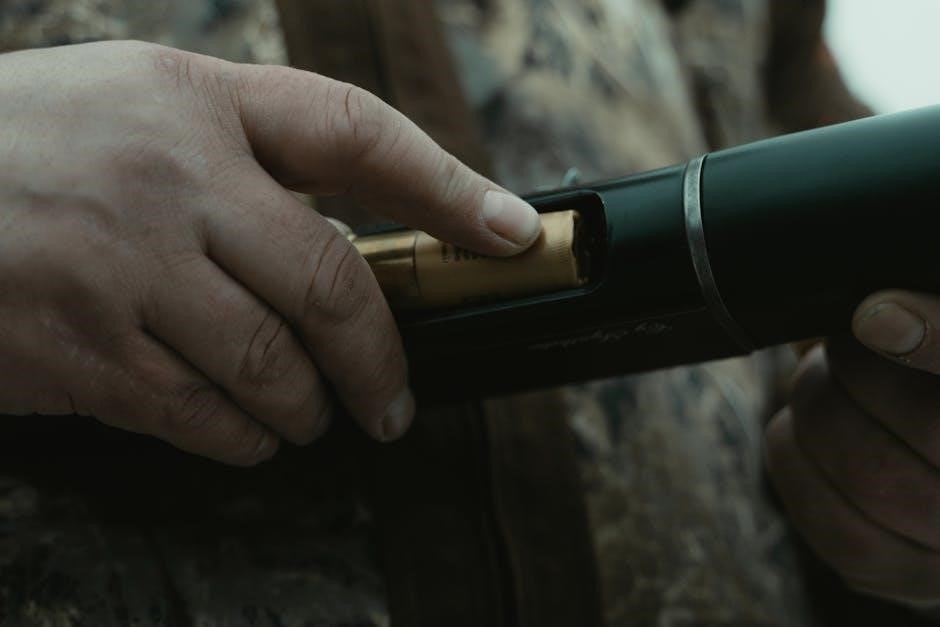Glock pistols are renowned for their reliability and the SAFE ACTION System, offering trigger, firing pin, and drop safeties. While not standard, manual safety options are available for added security.
1.1 Overview of Glock’s SAFE ACTION System
Glock’s SAFE ACTION System integrates three passive, mechanical safeties: trigger, firing pin, and drop. These safeties automatically deactivate sequentially as the trigger is pulled and reactivate once released, ensuring accidental discharges are prevented without requiring manual intervention; This system enhances safety while maintaining a smooth, consistent trigger pull, making it a cornerstone of Glock’s reputation for reliability and security in both civilian and law enforcement use.
1.2 Why Manual Safety is a Topic of Interest
Manual safety on Glocks sparks debate due to their existing SAFE ACTION System. Some users seek an additional layer of control, especially in high-stress situations, while others argue it complicates the draw process. The rare factory models, like the MHS submission, highlight its niche appeal, driving interest among enthusiasts and professionals seeking enhanced safety features without compromising Glock’s reliability.

Types of Safeties on a Glock
Glock pistols feature a SAFE ACTION System with trigger, firing pin, and drop safeties. Manual safety, though not standard, can be added for enhanced control, offering users an additional layer of security.
2.1 Trigger Safety
The trigger safety is a critical component of Glock’s SAFE ACTION System. It features a lever embedded in the trigger that must be depressed to fire, preventing accidental discharges. This mechanism ensures the pistol cannot fire unless the trigger is intentionally pulled. The safety automatically engages when the trigger is released, providing an additional layer of protection. It works seamlessly with the firing pin and drop safeties, enhancing overall safety without requiring manual intervention.
2.2 Firing Pin Safety
The firing pin safety is a mechanical blocker that prevents the firing pin from striking the primer unless the trigger is fully pressed. This passive safety automatically engages and disengages, ensuring the pistol cannot fire unintentionally. It is a key part of Glock’s SAFE ACTION System, providing an additional layer of protection against accidental discharges. The firing pin safety is internal and requires no manual intervention, making it a reliable and integral component of Glock’s design.
2.3 Drop Safety
The drop safety prevents the pistol from firing if dropped or subjected to impact. It is part of Glock’s SAFE ACTION System, automatically engaging to block the firing pin from striking the primer. This passive mechanism ensures the pistol cannot discharge unintentionally due to external forces. The drop safety, like the trigger and firing pin safeties, is internal and requires no manual activation, enhancing overall reliability and safety.

Manual Safety Options for Glock
Glock pistols do not come with a factory thumb safety, but aftermarket options are available. These manual safeties can be installed to provide an additional layer of control.
3.1 Aftermarket Manual Safety Installation
Aftermarket manual safeties for Glocks involve installing a thumb-operated lever, typically requiring slide modification. This process includes cutting a slot for the safety lever and fitting it securely. The installation ensures the safety engages smoothly, preventing accidental discharge. While the cost is moderate, around $138 for parts and labor, it adds a tactile layer of safety for users who prefer manual control over their firearm.
3.2 Cost of Adding a Manual Safety
The cost of adding a manual safety to a Glock typically ranges around $138, covering both parts and labor. This includes the safety lever itself and the necessary slide modifications. While the expense is moderate, it provides an additional layer of security for users seeking enhanced control. The installation is straightforward, ensuring reliability without compromising the pistol’s functionality or performance.
Comparison with Other Pistols
Glock’s manual safety feature stands out among competitors like Smith & Wesson M&P and SIG Sauer P320, offering a unique blend of reliability and user customization.
4.1 Smith & Wesson M&P with Manual Safety
The Smith & Wesson M&P pistol is a popular alternative to Glock, offering a built-in thumb safety for users who prefer an additional manual safety feature. Unlike Glock, the M&P’s manual safety is integrated into its design, providing a familiar control for those accustomed to 1911-style pistols. Its ergonomic design and ambidextrous thumb safety make it a strong contender for shooters prioritizing manual safety. This feature is particularly favored by law enforcement and tactical users seeking enhanced control.
4.2 SIG Sauer P320 with Manual Safety
The SIG Sauer P320 offers a modular design with optional manual safety configurations, appealing to users who prefer a thumb-operated safety. Unlike Glock, the P320’s manual safety can be added without modification, making it a versatile choice. Its ability to customize safety features while maintaining reliability and accuracy positions it as a strong competitor for those seeking a Glock-like pistol with additional control options, particularly in professional and tactical settings where manual safeties are often preferred.

Installation and Maintenance
Installing a manual safety on a Glock requires precise labor, including cutting a slot for the lever. Regular maintenance ensures smooth operation and reliability of the safety mechanism.
5.1 Process of Installing a Manual Safety
Installing a manual safety on a Glock involves cutting a slot in the frame for the safety lever and fitting the mechanism. This requires precision to ensure proper function. The process typically includes disassembling the pistol, modifying the frame, and reinstalling the safety components. Professional installation is recommended to maintain reliability and safety. Post-installation, thorough testing is essential to confirm the safety engages and disengages smoothly without affecting the trigger pull or firing mechanism.
5.2 Maintenance Tips for Glock with Manual Safety
Regular maintenance is crucial for a Glock with a manual safety. Ensure the safety lever is clean and free from debris to function smoothly. Lubricate moving parts periodically and inspect the safety mechanism for wear. After each use, check that the safety engages properly and doesn’t interfere with the trigger. Proper care extends the pistol’s reliability and ensures the safety system operates as intended, maintaining its effectiveness and durability over time.

Pros and Cons of Manual Safety
A manual safety on a Glock adds an extra layer of protection against accidental discharge but may also add bulk and complexity to the pistol’s design and operation.
6.1 Advantages of Adding a Manual Safety
Adding a manual safety to a Glock provides an extra layer of protection against accidental discharges, offering peace of mind. It appeals to users accustomed to thumb safeties, like those familiar with the Colt 1911. The manual safety can be easily engaged and disengaged, providing a tactile confirmation of the firearm’s status. This feature is particularly beneficial for users who prefer an additional safety mechanism, enhancing control and confidence in handling the pistol.
6.2 Potential Drawbacks of Manual Safety
Adding a manual safety to a Glock may require slide modification, potentially voiding the warranty. Installation costs around $138, and the process involves cutting the slide. Some users find the manual safety unnecessary, as Glocks already have a reliable SAFE ACTION System. The added mechanism may interfere with the pistol’s sleek design or holster compatibility. Additionally, maintaining the manual safety requires attention, and some shooters argue it complicates the intuitive operation of the firearm.
Rare Factory Glock Models with Manual Safety
Few factory Glock models feature a manual safety. The MHS submission is the most recent example, while limited edition models occasionally include this feature for specific purposes.
7.1 Glock MHS Submission
The Glock MHS (Modular Handgun System) submission was a rare factory model designed for military trials, featuring an optional manual thumb safety. This model aimed to meet specific military requirements, including an additional safety mechanism for enhanced control. It showcased Glock’s ability to adapt to different user needs while maintaining their renowned reliability and durability. However, it remains a limited production run, making it highly sought after by collectors and enthusiasts.
7.2 Limited Edition Models
Limited edition Glock models occasionally feature manual safeties, offering uniqueness for collectors. These rare versions, produced in small batches, cater to specific preferences. They maintain Glock’s reliability while adding a manual safety option for users seeking extra control. Such models are highly sought after due to their exclusivity and special features, blending tradition with enhanced safety for a distinct shooting experience.
Compatibility with Different Glock Models
Most Glock models, including Generation 4 and earlier, are compatible with manual safety installations. Exceptions include Glock 42, 43, and newer Generation 5 models.
8.1 Models Compatible with Manual Safety
Most Glock models, including the Glock 36 and all Generation 4 and earlier versions, are compatible with manual safety installations. Tactical models like the Glock 34 and 35 often fit as well. However, newer Generation 5 and single-stack models such as the Glock 42 and 43 are not compatible due to design differences. Installation typically requires minor slide modifications to accommodate the safety lever, ensuring proper function and reliability.
8.2 Models Not Compatible with Manual Safety
Certain Glock models, such as the slimline Glock 42 and 43, are not compatible with manual safety installations due to their narrower slides and design constraints. Additionally, Generation 5 models and the Glock 36 are typically excluded because of structural differences. These models cannot accommodate the necessary modifications without compromising their functionality or reliability, making manual safety additions impractical for these specific pistols.
Legal and Training Considerations
Modifying a Glock with a manual safety may have legal implications depending on local laws. Proper training is essential to ensure safe handling and operation.
9.1 Legal Implications of Modifying a Glock
Modifying a Glock with a manual safety may have legal implications, as it alters the firearm’s original design. Owners must ensure compliance with local laws and regulations.
Some jurisdictions restrict firearm modifications, and adding a manual safety could affect the pistol’s legal status. It is essential to consult legal experts before making such changes to avoid penalties.
9.2 Training Requirements for Manual Safety Use
Proper training is essential when using a Glock with a manual safety. Users must learn to engage and disengage the safety intuitively, ensuring it doesn’t interfere with their ability to respond quickly in high-stress situations.
Regular practice and drills are recommended to build muscle memory and maintain proficiency. It’s crucial to train with the safety to avoid accidental discharges and ensure safe, effective operation of the firearm.
Glock pistols are known for reliability and safety. Adding a manual safety provides an extra layer of security. Consider your needs and training before deciding.
10.1 Final Thoughts on Glock with Manual Safety
Glock pistols are highly reliable and safe, featuring the renowned SAFE ACTION System. Adding a manual safety offers an extra layer of control, appealing to those who prefer it. While not necessary for everyone, it provides peace of mind for some users. Compatibility varies across models, and proper training is essential. Ultimately, the decision to add a manual safety depends on personal preference, shooting style, and legal considerations.
10.2 Recommendations for Potential Buyers
For those considering a Glock with a manual safety, assess your needs and preferences. If additional control is desired, aftermarket options are available but require professional installation. Ensure compatibility with your specific Glock model. Consider alternatives like Smith & Wesson M&P or SIG Sauer P320 if factory options are preferred. Weigh the pros and cons, including cost and training, to make an informed decision that aligns with your safety and shooting requirements.